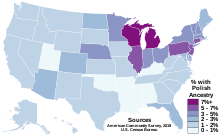
Back امريكيين بولنديين ARZ Poláci ve Spojených státech amerických Czech Inmigración polaca en los Estados Unidos Spanish Ameerikapoolakad Estonian لهستانیهای آمریکا Persian Amerikanpuolalaiset Finnish Polono-Américains French Poljaci u SAD-u Croatian Orang Polandia Amerika ID Polaccoamericani Italian
 Americans with Polish ancestry by state according to the U.S. Census Bureau's American Community Survey in 2019 | |
| Total population | |
|---|---|
| 8,810,275 (2.7%) alone or in combination 2,744,941 (0.8%) Polish alone | |
| Regions with significant populations | |
| Northeast (New York · New Jersey · Maryland · Connecticut · Massachusetts · Pennsylvania (Luzerne County and Lackawanna County)) Midwest (Michigan · Illinois · Wisconsin · Ohio · Minnesota · Indiana · North Dakota · Nebraska · Iowa (Sioux City) · Some in Kansas · Missouri) · California · Growing in Arizona · Florida · Colorado | |
| Languages | |
| English (American English dialects) · Polish | |
| Religion | |
| Predominantly Roman Catholicism · Protestantism · Judaism[3] | |
| Related ethnic groups | |
| Other Poles • Polish Jews • Texan Silesians • Kashubian Americans • Czech Americans • Slovak Americans • Sorbian Americans |

Polish Americans (Polish: Polonia amerykańska) are Americans who either have total or partial Polish ancestry, or are citizens of the Republic of Poland. There are an estimated 8.81 million self-identified Polish Americans, representing about 2.67% of the U.S. population, according to the 2021 American Community Survey conducted by the U.S. Census Bureau.[1]
The first eight Polish immigrants to British America came to the Jamestown colony in 1608, twelve years before the Pilgrims arrived in Massachusetts. Two Polish volunteers, Casimir Pulaski and Tadeusz Kościuszko aided the Americans in the Revolutionary War. Casimir Pulaski created and led the Pulaski Legion of cavalry. Tadeusz Kosciuszko designed and oversaw the construction of state-of-the-art fortifications, including those at West Point, New York. Both are remembered as American heroes. Overall, around 2.2 million Poles and Polish subjects immigrated into the United States between 1820 and 1914, chiefly after national insurgencies and famine.[4] They included former Polish citizens of Roman Catholic, Protestant, Jewish or other minority descent. Exact immigration figures are unknown. Many immigrants were classified as "Russian", "German" or "Austrian" by the U.S. Immigration and Naturalization Service as many former territories of Poland were under German, Austrian-Hungarian and Russian occupation between the late 18th and early 20th century. Complicating the U.S. Census figures further is the high proportion of Polish Americans who married people of other national descent. In 1940, about 50 percent married other American ethnics and a study in 1988 found that 54% of Polish Americans were of mixed ancestry from three generations or longer. The Polish American Cultural Center places a figure of Americans who have some Polish ancestry at 19–20 million.
In 2000, 667,414 Americans over five years old reported Polish as the language spoken at home, which is about 1.4% of the census groups who speak a language other than English or 0.25% of the U.S. population.
- ^ a b "Table B04006 - People Reporting Ancestry - 2021 American Community Survey 5-Year Estimates". United States Census Bureau. Archived from the original on December 12, 2022. Retrieved March 6, 2023.
- ^ "IPUMS USA". University of Minnesota. Retrieved October 12, 2022.
- ^ One Nation Under God: Religion in Contemporary American Society, p. 120
- ^ Polonia amerykańska, p. 40
© MMXXIII Rich X Search. We shall prevail. All rights reserved. Rich X Search